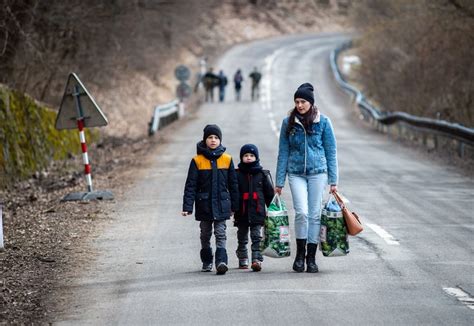
Ukraine faces a looming demographic crisis as the disproportionate exodus of young women threatens the nation’s long-term recovery and social fabric, exacerbating existing challenges of war and economic instability.
The ongoing conflict in Ukraine has triggered a mass departure of its citizens, but a concerning trend has emerged: a significant gender imbalance in the refugee flow, with young women leaving the country at a higher rate than men, or older women. This “silent crisis,” as described by experts, poses severe implications for Ukraine’s future demographic structure, workforce, and overall societal well-being, according to the United Nations High Commissioner for Refugees (UNHCR). The flight of young women, often the most educated and skilled segment of the population, endangers the nation’s potential for rebuilding and economic growth after the war.
The reasons behind this gendered migration pattern are complex and multifaceted. The primary driver, of course, is the war itself. With men aged 18-60 largely prohibited from leaving the country due to mobilization laws, women, along with children and elderly individuals, have become the majority among those seeking refuge abroad. “The war has created a situation where women are disproportionately represented among refugees,” notes a recent report by the International Organization for Migration (IOM). This initial displacement has been further compounded by other factors that make remaining in Ukraine, or returning, less appealing for young women.
One major factor is the limited economic opportunity within Ukraine, as the destruction caused by the conflict has devastated numerous industries, leading to widespread unemployment and financial uncertainty. Young women, particularly those with skills and education that are in demand in Western economies, are more likely to seek better prospects abroad. The promise of higher wages, stable employment, and greater personal safety is a significant draw, especially in countries offering pathways to permanent residency and citizenship.
Furthermore, the psychological toll of the war cannot be overstated. Many young women have experienced trauma, loss, and displacement, which makes starting over in a new country, despite its challenges, a more appealing option than returning to a war-torn environment. Access to mental health support and social services in host countries also plays a role, as these resources may be limited or unavailable in Ukraine. The extended family support networks that traditionally sustained Ukrainian society have also been fractured by the war, adding to the sense of isolation and vulnerability that some young women experience.
The educational opportunities available to young women also drive migration decisions. Universities and colleges across Europe and North America are actively recruiting Ukrainian students, offering scholarships, and streamlined admission processes. This provides an attractive option for young women who wish to continue their education without the disruptions and dangers posed by the war. Once enrolled in these programs, many are likely to remain in their host countries after graduation, further contributing to the demographic imbalance in Ukraine.
The consequences of this female exodus are far-reaching. A shrinking and aging population can lead to labor shortages, reduced productivity, and a decline in the tax base, hindering economic recovery and development. The social fabric of Ukrainian society is also threatened, as the absence of young women can lead to a decline in marriage rates, birth rates, and community engagement. The emotional and social support that women traditionally provide within families and communities is also diminished, exacerbating the psychological impact of the war on those who remain.
Moreover, the disproportionate loss of young women can lead to a distortion of traditional gender roles and power dynamics. With fewer women in the workforce and leadership positions, there is a risk of reinforcing patriarchal norms and limiting women’s opportunities for advancement. This can further discourage young women from returning to Ukraine after the war, creating a self-perpetuating cycle of emigration.
Addressing this demographic crisis requires a multifaceted approach. The immediate priority is to end the war and create a safe and stable environment that encourages refugees to return. This includes providing security guarantees, demining liberated territories, and rebuilding critical infrastructure. Simultaneously, Ukraine needs to implement policies that support economic recovery and create opportunities for young people, especially women.
These policies should focus on attracting foreign investment, promoting entrepreneurship, and developing industries that offer high-paying jobs. Investing in education and skills training is also crucial to ensure that young women have the qualifications needed to succeed in the modern economy. Furthermore, the government needs to address the psychological impact of the war by expanding access to mental health services and providing support to families and communities.
Efforts to encourage Ukrainian refugees to return home should be carefully designed to address the specific concerns and needs of young women. This includes providing financial assistance, affordable housing, and childcare support. It is also essential to combat misinformation and create a positive narrative about the future of Ukraine. The government should work closely with diaspora communities and international organizations to promote the benefits of returning and to facilitate the reintegration process.
Ultimately, addressing the “silent crisis” of female emigration requires a long-term commitment to building a more inclusive, equitable, and prosperous society in Ukraine. This includes promoting gender equality, empowering women in leadership roles, and creating a society where young women feel safe, valued, and supported. By addressing the root causes of emigration and creating a more attractive environment for young women, Ukraine can reverse the demographic trend and ensure a brighter future for its citizens.
Furthermore, international support is crucial. Aid packages should be designed to specifically address the needs of women and girls, including funding for education, healthcare, and economic empowerment programs. Host countries should also provide support for Ukrainian refugees to maintain their cultural identity and connections to their homeland, which can make it easier for them to return when the time is right.
The challenges facing Ukraine are immense, but the country has demonstrated remarkable resilience and determination in the face of adversity. By recognizing and addressing the “silent crisis” of female emigration, Ukraine can lay the foundation for a sustainable and prosperous future. The rebuilding of Ukraine will rely on a population balanced in gender and age, thus every effort to support woman and family well-being will accelerate the recovery.
Additional Details and Context:
The war in Ukraine has created the largest refugee crisis in Europe since World War II, with millions of people fleeing the country in search of safety. While the scale of the displacement is unprecedented, the gendered nature of the refugee flow is particularly concerning. According to UNHCR data, women and children account for the vast majority of Ukrainian refugees, while men between the ages of 18 and 60 are largely prohibited from leaving the country due to martial law and mobilization efforts.
This has resulted in a demographic shift within Ukraine, with a disproportionate number of women, children, and elderly people remaining in the country, while many young men are either fighting on the front lines or have been displaced internally. This demographic imbalance has profound implications for the country’s economy, social fabric, and future development.
The economic impact of the war on Ukraine has been devastating. The World Bank estimates that the Ukrainian economy contracted by 30% in 2022, and the ongoing conflict continues to disrupt economic activity. Many businesses have been forced to close, and millions of people have lost their jobs. The destruction of infrastructure, including roads, bridges, and factories, has further hampered economic recovery.
The war has also had a severe impact on the social fabric of Ukrainian society. Millions of people have been displaced from their homes, and many have lost loved ones. The psychological toll of the war is immense, with many Ukrainians experiencing trauma, stress, and anxiety. The breakdown of social support networks has further exacerbated the challenges facing families and communities.
In addition to the immediate challenges posed by the war, Ukraine also faces long-term demographic challenges. The country’s population has been declining for decades due to low birth rates and high emigration rates. The war has accelerated this trend, with millions of people leaving the country, many of whom are unlikely to return.
The exodus of young women is particularly concerning, as they are essential to the country’s future economic and social development. Young women are more likely to be educated and skilled, and they play a vital role in the workforce. They are also the primary caregivers for children and elderly family members. The absence of young women can lead to labor shortages, reduced productivity, and a decline in the tax base. It can also undermine the social fabric of communities and families.
The Ukrainian government has implemented a number of policies to address the demographic challenges facing the country. These include measures to support families with children, promote gender equality, and attract foreign investment. However, these policies are unlikely to be effective unless the war ends and a stable and secure environment is established.
International support is also crucial. The international community needs to provide financial assistance, humanitarian aid, and technical assistance to help Ukraine rebuild its economy and society. It also needs to support Ukrainian refugees in host countries and help them return home when the time is right.
The rebuilding of Ukraine will be a long and difficult process, but it is essential for the country’s future. By addressing the demographic challenges facing the country, and in particular the exodus of young women, Ukraine can lay the foundation for a sustainable and prosperous future.
Quotes:
- “The war has created a situation where women are disproportionately represented among refugees,” – IOM report
- A Ukrainian woman living in Berlin said, “I want to return and help rebuild my country, but I need to know that my children will be safe and have opportunities for a good future.”
Frequently Asked Questions (FAQ):
1. Why are young women leaving Ukraine in disproportionate numbers compared to men?
The primary reason is the war and martial law restrictions preventing men aged 18-60 from leaving. Beyond this, limited economic opportunities in Ukraine, greater access to education and employment abroad, the psychological impact of the war, and the promise of greater stability and safety in host countries also contribute to the higher rate of female emigration. The draw of joining family already abroad and concerns for children’s futures further influence their decisions.
2. What are the potential long-term consequences of this demographic imbalance for Ukraine?
A shrinking and aging population will cause significant labor shortages, reduced economic productivity, and a decline in the tax base, hindering economic recovery. Socially, it could lead to decreased marriage and birth rates, weakening communities, and a potential distortion of gender roles, reinforcing patriarchal norms due to fewer women in the workforce and leadership positions.
3. What steps can the Ukrainian government take to encourage young women to return after the war?
The government must prioritize ending the war and creating a safe and stable environment. Economic policies should focus on attracting foreign investment, promoting entrepreneurship, and developing high-paying industries. Investing in education, skills training, mental health services, and providing financial assistance, affordable housing, and childcare are also crucial incentives. Combating misinformation and fostering a positive narrative about Ukraine’s future is key.
4. How can international organizations and host countries support Ukraine in addressing this demographic crisis?
International organizations can provide financial assistance specifically targeting the needs of women and girls, including funding for education, healthcare, and economic empowerment programs. Host countries should offer support for Ukrainian refugees to maintain their cultural identity and connections to their homeland. Coordinated efforts with the Ukrainian government and diaspora communities are essential to facilitate reintegration when refugees choose to return.
5. What role do educational opportunities in foreign countries play in the emigration of young Ukrainian women?
Foreign universities actively recruit Ukrainian students, offering scholarships and streamlined admission processes. This presents an attractive path for young women to continue their education without war-related disruptions. Once enrolled, many are likely to remain in their host countries after graduation, further impacting Ukraine’s demographic balance. This underlines the need to offer compelling educational and career opportunities within Ukraine to retain talent.
6. What are some of the psychological effects of the war that impact women’s decisions to stay or leave Ukraine?
The psychological toll of the war is substantial. Trauma from witnessing violence, displacement, and loss contribute to feelings of stress, anxiety, and hopelessness. The breakdown of social support networks, limited access to mental health services within Ukraine, and the desire to protect children from further trauma all influence the decision to seek refuge and a fresh start in a safer environment.
7. How does the internal displacement of Ukrainian citizens affect the decision-making of young women regarding emigration?
Internal displacement can exacerbate existing vulnerabilities and create new challenges for young women. Loss of homes, jobs, and social connections can make it difficult to rebuild their lives within Ukraine. The uncertainty and instability of living in temporary accommodation, coupled with limited economic opportunities in internally displaced persons (IDP) communities, can make emigration seem like a more attractive option for a stable and secure future.
8. What specific types of jobs or industries should Ukraine focus on developing to attract young women back to the country?
Ukraine should prioritize developing industries that offer high-paying jobs and opportunities for career advancement for women, such as technology, information technology (IT), healthcare, education, finance, and creative industries. Promoting entrepreneurship and supporting small businesses owned by women are also important strategies. Investing in vocational training programs that align with the needs of the modern economy can help equip young women with the skills they need to succeed.
9. How can the Ukrainian government work with diaspora communities to encourage the return of young women?
The Ukrainian government should actively engage with diaspora communities to build trust and foster a sense of connection with the homeland. This can involve providing information about opportunities in Ukraine, facilitating networking events, and offering incentives for diaspora members to invest in or start businesses in Ukraine. Creating mentorship programs that connect young women in the diaspora with professionals in Ukraine can also be beneficial.
10. What are some potential challenges and obstacles that the Ukrainian government might face in implementing policies to address this demographic crisis?
The ongoing war and political instability pose significant challenges to implementing effective policies. Corruption, lack of resources, and bureaucratic inefficiencies can also hinder progress. Overcoming deeply entrenched social norms and gender stereotypes that limit women’s opportunities will require a sustained and multifaceted effort. Ensuring that policies are inclusive and address the needs of all women, regardless of their background or circumstances, is also crucial.









